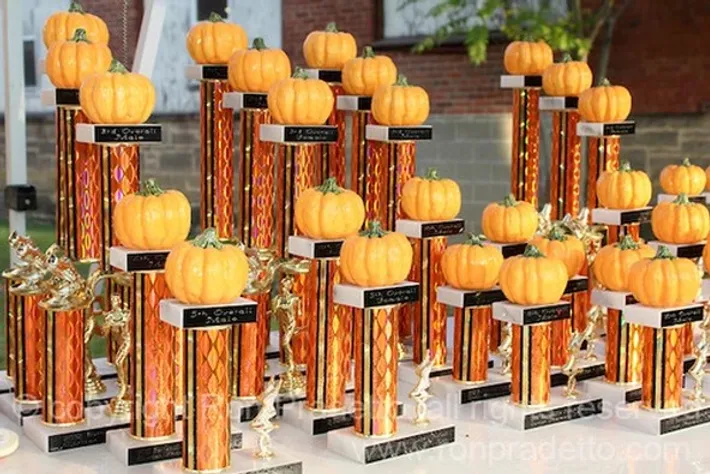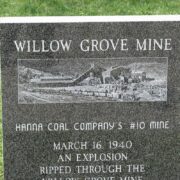
The Barnesville Pumpkin Festival- How it All Started

With the Barnesville Pumpkin Festival being cancelled, we will miss the annual event. And although many of us make the annual trip to the downtown streets of Barnesville Ohio, I wonder how many of us know how this event, that attracts thousands of people, got it’s start.
Vernon Burkhart, a resident of Barnesville, Oh, started a small fair in the fall of 1964. It was held in the Assumption Catholic Church basement and was known as the Barnesville Fall Fair. Burkhart’s inspiration for the event came from a trip through Tennessee with his wife in 1963 where they passed through a small town having a fall festival.
The Barnesville three-day fair attracted many people “offering the opportunity to see and enjoy the plentiful things that are grown on the beautiful acres of southeastern Ohio,” including large gourds, many being pumpkins. The event, now a festival, became so popular that it had to be moved outside, still in the community on West Main Street in 1968. A board of directors was formed, and Burkhart served as the festival’s first president. Many of the festival’s contests and events were developed. The festival’s first queen was crowned in 1968, the same year that the Barnesville Mother’s Club added the “Little Miss and Mr. Pumpkin” contest, and the most popular “King Pumpkin” contest. The antique window display contest also began in 1968 and carnival rides were added in 1969.
Community involvement has been an integral part of the festival from the very beginning. At that first affair, Barnesville High Vo-Ag students served as judges as they do to this day, setting up early wide-spread community involvement in the festival. Early financial support came from local businesses and the invaluable support of the village government, which still exist.
In 1970, the name was changed to the Ohio Pumpkin Festival. That year also saw the festival’s first street parade and the introduction of pumpkin ice cream, manufactured locally by Damsel’s. This same year saw the first “King Pumpkin” display on Main Street. Expansions included a Banjo and Fiddle Contest, the Big Pumpkin Auction (1976), Pumpkin Run, (1977), and Pet Show (1980) among others.
By ’80s the Wednesday night weighing of the giant pumpkins gained popularity and Saturday parade day crowds were estimated at 50,000. Still growing in popularity, the festival expanded its boundaries to the B & O Depot and Watt Center areas.
During its history, the festival has drawn its fair share of celebrities and brought national attention to Barnesville. Miss America 1971, Ohio’s Laurie Lee Schafer was a special guest in 1974. The 150-member Ohio University Bobcat Marching Band livened up the 1974 parade. The Ohio State University Football Coach Woody Hays cut the ribbon in 1980 as did Ohio Department of Agriculture Director Harry Goldstein four years later. Also, in the ’80s, the late Ed Johnson, host of the popular Agri-Country television show, broadcast from Barnesville and served as weigh master.
In 1999, the festival was featured on the NBC Today Show, The Discovery Channel and named as one of the top 100 Events in the United States by the American Bus Association.
In 2002, the name was changed to the Barnesville Pumpkin Festival. Attendance is now typically over 100,000 people for the four-day event.
The highlight of the festival is the “King Pumpkin” weigh-in, in which $1.00 per pound is paid to the grower of the heaviest pumpkin. The Barnesville Pumpkin Festival still boasts the Ohio state record winning pumpkin, grown in 2017 by natives Todd and Donna Skinner and tipping the scale at 2,150 pounds, a far cry from the winning entry of then 12-year-old Thomas Rockwell in 1964, when the contest began. The Skinner’s pumpkin helped them earn the 2017 Worldwide Great Pumpkin Commonwealth Grower of the Year title. The “King Pumpkin” is auctioned off on Saturday night, and the highest bidder takes custody of the pumpkin for 10 days, usually displaying it at their business. After that, the pumpkin is returned to the festival organizers, gutted, and its seeds are dried and packaged to be sold at the next year’s festival.
To date, other festival activities include concessions, carnival rides, a queen pageant, pumpkin baby, little Miss and Mr. and mascot contests, a classic and antique car show, live entertainment on two stages, pumpkin pie baking and eating contests, pumpkin fudge contest, pumpkin rolling contest, horticulture displays, farm machinery display, tall tales, hog-calling, tobacco-spitting contest, beard and mustache contest, a pet contest, talent contest, banjo, fiddle and mandolin contest, a 5 K race, and a giant pumpkin parade.
Marking its 57th year, the pumpkin weigh-ins will be the only part of the festival that will take place. This was an exceedingly difficult decision to make for all involved. But due to the Corona virus pandemic, is was the decision that had to be made.
Want to try your hand at growing a giant pumpkin?
Todd Skinner, who has won the title six times, says good seeds are one of the most important requirements. The growing process begins in March when the soil is tested. In April, soil amendments are added, and seeds are started indoors between April 10-25. The soil temp needs to be 85-90 degrees, and the soil should be moist but not wet. Skinner uses seaweed solution to moisten the soil, which helps with the germination rate. After 3-5 days when the seedling pops up, it is put in direct sunlight or under a fluorescent light, but for no more than 10 hours a day.
In 7-10 days, the young seedlings are transplanted outside in a “hoop house” covered in clear plastic. The temperature needs to be regulated so that between 60-70 degrees, by opening vents on the side of the hoop house or using a small ceramic heater. The plants must be watered daily, just enough to moisten the soil in a 2-foot circle around the plant. Fertilizer is used once a week and includes seaweed, fish emulsions, and calcium.
By the end of May, the young plant should be outgrowing the hoop house. At this time, it is removed, and the plant is pruned, training and covering secondary vines with dirt to encourage secondary rooting. With the hoop house down, a wind tunnel needs to be installed to keep high winds from destroying the pumpkin plants. May also begins the application of regular pesticides and fungicides.
Pumpkins are started on the main vine 10-15 feet out by hand pollinating. To do that, you take the pollen of a newly opened male blossom and dab it on a newly opened female blossom on another plant. Doing this, gives you cross pollination of the genetics. Of course, you can also let the bees do the pollinating.
Two or three pumpkins are started on the main vine and allowed to grow to basketball size. Then one is chosen for continued growth based on shape and growth speed, with the others getting cut off the vine. At this stage, foam or sand is placed under the young pumpkin making a flat, well-drained surface for the public to grow. More sand or foam is added as the pumpkin grows.
As the pumpkin grows, the vine is raised with the pumpkin stem to relieve stem stress. A light-colored sheet is kept over the pumpkin to help protect the skin from the sun. As the pumpkin grows, the main vine from the stump out to the stem needs to be kept healthy and free of rot and soft spots. Those spots are scraped off with a knife and cleaned with bleach and a brush to sterilize the area.
Skinner says giant pumpkin growing can be either heart-breaking or rewarding. The ultimate reward is of course, making it to the King Pumpkin platform.






